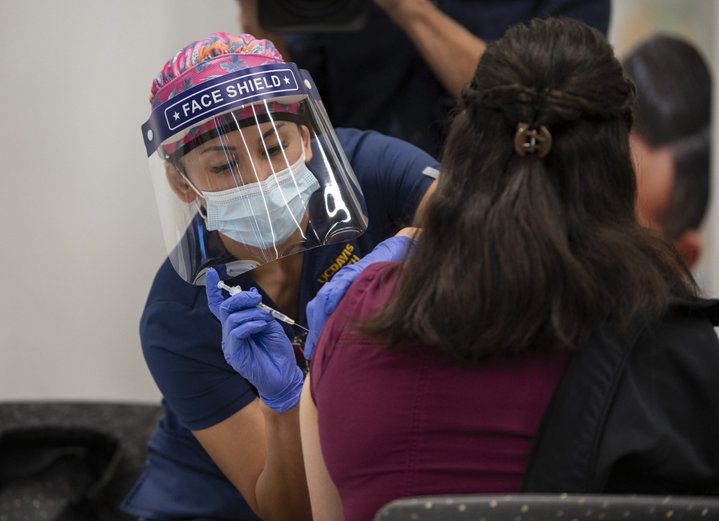
Registered Nurse Reanne Takara administers the Pfizer COVID-19 vaccine to frontline health workers at UC Davis Medical Center on Dec. 15, 2020. Photo courtesy of UC Davis Health
###
Californians largely agree that frontline health care workers and folks in nursing homes should be the first to get the new COVID-19 vaccines. There’s far less consensus over who should come next.
The federal Advisory Committee on Immunization Practices recently recommended the second priority group should include frontline essential workers and people over 75. In doing so, the panel tried to balance the competing interests of keeping society functioning, by protecting essential workers, and saving lives, by protecting elderly Americans who are most likely to die if infected.
Most states, including California, have signaled that they’ll largely abide by the federal panel’s guidance. But states are allowed to set their own priorities. On Monday, Gov. Gavin Newsom said more than 70,000 first doses of the Pfizer vaccine were given last week and that the state expects more than 560,000 doses to be delivered before the end of the year. Newsom also announced that 672,600 doses of the newly authorized Moderna vaccine is expected to be delivered this week.
Last week, California’s own expert advisory panel presented its preliminary recommendations for who should get the vaccine next, suggesting education and childcare workers, first responders such as police officers and firefighters, and food and agricultural workers including grocery and restaurant workers. Older Californians, unless they fall into one of these essential worker categories, were not included in the working group’s highest priority within the second group to be vaccinated.
The California panel is expected to issue its final guidance for the second vaccine priority group this month. Once that happens, state and county officials are expected to abide by that guidance in distributing still-scarce vaccine doses. But in a state as large and diverse as California, individual counties will have some leeway in arranging the line. That has sparked a lot of lobbying by unions and other interest groups who argue their workers are more essential than others.
Uber and Lyft, for example, have asked state governors to prioritize its drivers. Other groups are advocating to prioritize teachers and migrant workers. Still other advocates want to elevate more vulnerable people, including prisoners, the homeless and the disabled.
How will counties decide who’s most important to vaccinate first?
Might an agricultural county like Fresno, for example, place farmworkers disproportionately infected with COVID-19 ahead of teachers while vaccine supplies remain limited? Could Orange County, thinking of tax revenues, push Disneyland workers ahead of teachers?
A handful of elected officials told CalMatters that for now, they’re planning to abide by priorities set by state and local public health officials, but they’re not yet being pressured by interest groups.
Some health advocates say they’re worried that individual county decisions might create a patchwork of priorities that will be difficult to monitor. People might travel to another county that considers them higher priority than their home county.
“I’m concerned that counties are making their own decisions (during) this period of time … where we have some vaccine but not enough,” said Anthony Wright, executive director of the advocacy group Health Access, at last week’s meeting of the state’s Community Vaccine Advisory Committee. “Once people think that other people are cutting the line, that dissolves the social compact we’re all in, and that really scares me.”
At a briefing last week, Newsom said that the state “sets the tone” and recommends who should get priority, but allows counties discretion within the guidelines. California’s top health official, Dr. Mark Ghaly, added that the state public health department is coordinating with counties to move in the same direction.
Some labor groups have already begun outreach to county health departments — asking how closely they plan to follow the state’s guidelines but also asking them to keep its members in mind.
“The county systems have their ear on the ground, they can determine where they need to see stuff happen fast. They could decide to follow the state’s recommendations or take a different route,” said Matthew Maldonado, director of internal operations with United Domestic Workers, which represents about 140,000 child care workers and home health aides in the state.
Los Angeles County public health officials will consult with the county’s board of supervisors, but supervisors will not vote on the plan, a supervisor’s aide said.
In Placer County, Supervisor Kirk Uhler said he has not yet been lobbied to prioritize certain groups, but he said he would defer to the county’s health department on vaccine priorities. “We’re going to leave that up to our health care professions,” he said. Still, he said he hopes people over 65 will be first in line.
Assemblymember Jordan Cunningham said he doesn’t think counties will have the flexibility to stray too much from the state’s recommendations. The San Luis Obispo Republican recently sent a letter to Dr. Mark Ghaly’s Health and Human Services office asking that teachers be next in line so that children can go back to school.
“But if counties do have enough say,” Cunningham said, “the first call I’ll make will be to my two (local) public health directors to prioritize teachers and educators.”
Max Arias, executive director with SEIU 99, which represents school employees including cafeteria staff, janitors and teacher aides, said his union has not lobbied counties. Most of its members would fall in line in the same group as teachers. You need them all to make a school function, Arias said.
His more immediate concern is providing education to his union’s members around vaccine safety.
“There is a lot of fear based on mistrust,” Arias said. “In some cases, the fear for the vaccine is as much as the fear for COVID,” he said.
###
CALmatters.org is a nonprofit, nonpartisan media venture explaining California policies and politics.
CLICK TO MANAGE